GARDENS BY THE BAY

EDGING PERENNIALS & THEIR COMPANIONS - 2
Nothing starts the explosion of colour in the garden with more impact than vibrant-coloured spring-blooming edging plants. But the excitement isn't restricted only to the first flush of spring bloom. Many edgers that bloom throughout the season are available as are some that provide and maintain interest by way of their variegated or nicely-textured foliage.
Beginning with blue Veronica whitleyi, the earliest spring-blooming edger in my Zone 5 gardens, to Ceratostigma plumbaginoides, the last to exhaust itself in fall, they set off the rest of the gardens to perfection. Consider some of the following perennials as suitable companions for every type of edging plant.
* Watch for the animated hummingbird and butterfly with the plants that attract them. *
The deer icon indicates plants that deer are not usually attracted to.
   The best time and method to propagate plants can be found on our image-intensive PROPAGATION page.
To help your plants grow their best, check out our FERTILIZATION page.
To create your own plant partnerships based on tried and true color theory, check out our GARDEN COLOR page.
To see if a particular plant is on this page press Ctrl+F, type in the name, then click the Find button.
The best time and method to propagate plants can be found on our image-intensive PROPAGATION page.
To help your plants grow their best, check out our FERTILIZATION page.
To create your own plant partnerships based on tried and true color theory, check out our GARDEN COLOR page.
To see if a particular plant is on this page press Ctrl+F, type in the name, then click the Find button.
NEPETA
 This is one of those perfect perennials whose mere presence makes its neighbours seem more vibrant because of its proximity. Perfect with paler shades of pink or yellow, it serves more vivid companions well too. Cutting back hard after the first flush encourages rebloom until fall, making it ideal near later-blooming perennials as well as early ones. What more could you ask of any plant?
Nepeta x faassenii: Catmint
This is one of those perfect perennials whose mere presence makes its neighbours seem more vibrant because of its proximity. Perfect with paler shades of pink or yellow, it serves more vivid companions well too. Cutting back hard after the first flush encourages rebloom until fall, making it ideal near later-blooming perennials as well as early ones. What more could you ask of any plant?
Nepeta x faassenii: Catmint
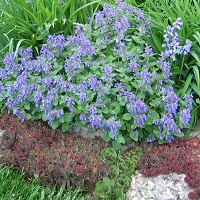 
above left: over a low edging of red-foliaged Hens and Chicks
above right in front of: strappy Hemerocallis foliage & a single red Paeonia tenuifolia (early-blooming Fernleaf Peony)
where: edging for walks, beds, rock walls, as a ground cover, used in drifts
generally with: brighter-coloured perennials
combined with: Acanthus mollis, Echinacea purpurea 'Bright Star' or 'Magnus' & Hemerocallis 'Yesterday Memories'
combined with: Achillea 'Coronation Gold', Lavandula 'Munstead', Lilium, Lythrum, Salvia & Veronica
combined with drought-tolerant plants: Echinops ritro, Achillea, Papaver orientale, Rudbeckia & Ornamental Grasses
combined with: Alchemilla mollis & Stachys byzantina & Stachys 'Helene von Stein' (a huge-leaved form)
combined with: Geranium endressii 'Wargrave Pink', Salvia nemorosa 'Superba', Campanula, Phlox, Oenothera & Iris
combined with: Centranthus ruber, Centranthus ruber 'Snowcloud' & Centaurea montana
with: Phlox subulata (especially pink, but with most other colours as well)
with:; Veronica spicata
with: Filipendula vulgaris, Heuchera x brizoides, Hemerocallis spp.
with: Platycodon grandiflorus (taller forms as well as the 15" dwarf 'Sentimental Blue')
with: Verbena, Geranium, Paeonia, Coreopsis, Verbascum including V. chaixii
with: Achillea 'Moonshine', Allium forms, Aquilegia x hybrida, Papaver orientale
with: Oenothera fruticosa, Oenothera speciosa or Oenothera tetragona 'Youngii'
drifted beside: Dianthus spp, especially bright pink-coloured forms
drifted beside: Dianthus x alwoodii, Dianthus caesius (D. gratianopolitanus) including 'Tiny Rubies',
Dianthus 'Brilliant Cascade', Dianthus plumarius (low-growing Cottage Pinks)
with: Cheiranthus, Lychnis (white forms)
beside: Arabis caucasica, Artemisia schmidtiana nana 'Silver Mound'
in front of: Tanacetum coccineum (formerly Chrysanthemum coccineum)
in front of: Tulipa (pink, pale yellow or crimson), Iris sibirica,
under: roses (especially white or pink)
taller types with: Achillea, Oenothera, Eryngium
Nepeta 'Blue Wonder': deep blue
edging combo with:: Achillea 'Moonshine', Coreopsis 'Moonbeam', Arrhenatherum elatius var. bulbosum
'Variegatum' (cream-striped) & Stachys byzantina 'Silver Carpet' (non-flowering)
with: Hemerocallis (a lemony-yellow shade)
with: Heuchera micrantha 'Palace Purple', Kniphofia x pfitzeri
Nepeta 'Dropmore Blue': a bright blue Canadian hybrid
near: Tanacetum coccineum (rose or crimson shades)
combined with: Tulipa (yellow or lavender), Iris x germanica (violet or purple intermediates) & Allium aflatunense
with: roses, hybrid tea roses
Nepeta 'Six Hills Giant': deep violet, 3 feet tall
beside: Rosa 'Pearl Drift'
in front of: Geranium wallichianum 'Buxton's Variety'
combined with: Phlomis russeliana (and other pale yellow flowers), Alchemilla mollis, Rosa 'Graham Thomas' (golden)
Nepeta sibirica: Siberian Catmint
with: Allium christophii & Salvia x superba 'East Friesland'
combined with: Phlox paniculata 'Miss Lingard' or 'Rosalinde' or its cousin Calamintha nepetoides
behind: Tulipa, to cover up their dying foliage
Nepeta sibirica 'Blue Beauty': lavender-blue
synonym: 'Souvenir d'André Chaudron' in Europe
drifted beside: Achillea 'Moonshine'
with; Achillea millefolium 'Terra Cotta' & Caryopteris 'Worcester Gold' (for a spectacular effect)
Follow the links below for more information about the care of the Catmint genus.
blue Catmint
Catmint with silver foliage
OENOTHERA
 There are many members of the Sundrops family of perennials that grace the middle sections of a garden. Fortunately there is one form, the Missouri Evening Primrose, that provides a wonderful accent at garden edges. Here its huge, clear yellow, 5" wide blooms first appear in late spring. If it can spill over a rock edge, the plant can be assured of the excellent drainage it requires to thrive.
Oenothera macrocarpa: Ozark Sundrops
There are many members of the Sundrops family of perennials that grace the middle sections of a garden. Fortunately there is one form, the Missouri Evening Primrose, that provides a wonderful accent at garden edges. Here its huge, clear yellow, 5" wide blooms first appear in late spring. If it can spill over a rock edge, the plant can be assured of the excellent drainage it requires to thrive.
Oenothera macrocarpa: Ozark Sundrops
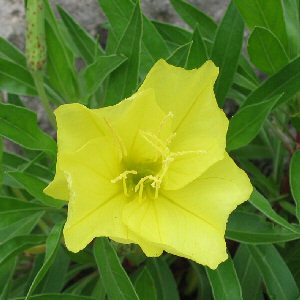
formerly: Oenothera missouriensis
where: front border position, rock gardens, meadow gardens
with: Nepeta x faassenii, Iris x germanica, Phlox, Geranium, Achillea
beside: Campanula carpatica, Dianthus, Hemerocallis, Lychnis chalcedonica, Stokesia laevis
in front of: Eryngium
Oenothera macrocarpa 'Green Court': sulphur yellow
Oenothera missouriensis: Ozark Sundrops
now reclassified as: Oenothera macrocarpa - see above
You will find both information and partnership ideas for these plants at the links below.
pink Sundrops
yellow Sundrops
PHLOX
  These edgers are wonderful for spilling over rock edges and come in an amazing array of colours for combining with many other perennials, bulbs and grasses. Just picture the following combinations, pick your favourites and go out to the garden to recreate any of the following scenes that are sure to invite comment from visitors to your garden.
Phlox subulata: Moss Phlox, Creeping Phlox
These edgers are wonderful for spilling over rock edges and come in an amazing array of colours for combining with many other perennials, bulbs and grasses. Just picture the following combinations, pick your favourites and go out to the garden to recreate any of the following scenes that are sure to invite comment from visitors to your garden.
Phlox subulata: Moss Phlox, Creeping Phlox
with grasses: Carex glauca
with other perennials: Dianthus spp., Euphorbia myrsinites
with other spring bloomers: Iberis sempervirens
Phlox subulata: most colours
with: Sedum, Penstemon, Nepeta x faassenii, Yucca
with early spring bloomers: Arabis caucasica, Aurinia saxatilis
with perennials: Anemone pulsatilla (now Pulsatilla vulgaris)
with bulbs: Narcissus jonquilla, Endymion hispanicus, Tulipa (pink or dark purple)
in front of other bulbs: Tulipa (try pink shades or a white form)
in front of perennials: Sedum spectabile
Phlox subulata: white forms
combined with other white bulbs: Tulipa or Hyacinthus
beside: Iris (apricot dwarf)
in front of other bulbs: Tulipa (yellow lily-Flowered), Allium 'Purple Sensation'
Phlox subulata: lavender-blue forms
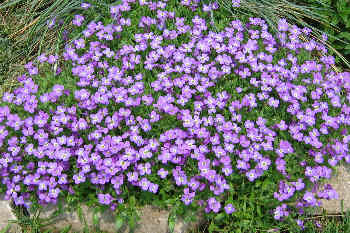
seen in the photo above cascading over a rock edge
with bulbs: Convallaria majalis
combined with: Tulipa (buttery or peach), Dicentra spectabilis (white) & Iris (creamy to orange early Bearded)
Phlox subulata: pink forms
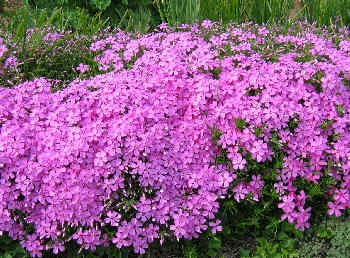
seen above doing what it does best - hug and cascade over a rock edge, flaunting its bright early spring colour
near bulbs: Narcissus jonquilla, Tulipa kaufmanniana or clusiana, Endymion hispanicus
near perennials: Arabis, Iberis, Pulsatilla vulgaris, Nepeta x faassenii
beside: Dianthus caesius, Lavandula 'Hidcote Blue'
in front of bulbs: Tulipa (pink, short white, crimson and/or dark purple)
with: hybrid Tulipa, early Narcissus
in front of perennials: Sedum spectabile, Iris sibirica (a blue form such as 'Orville Fay')
combined with: Tulipa (white), Iris (sky blue Intermediate), Narcissus poeticus (white), Tulipa (dark plum) &
Phlox subulata 'Atropurpurea': variously described as wine or carmine or rosy red
Phlox subulata 'Benita': lilac-blue with a darker eye
with: Convallaria majalis
Phlox subulata 'Blue Emerald': "Moonlit" Creeping Phlox, pale to medium blue
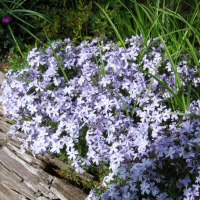
synonym: 'Emerald Blue'; pale lilac-blue (silvery lilac) excellent foliage
with early bloomers: Aurinia saxatilis, Arabis, Convallaria majalis
with: Sedum, Penstemon, Yucca,
in front of: Tulipa (any colour from strong orange to pale pink)
Phlox subulata 'Rosette': compact rose-pink
with: Aurinia saxatilis, Sedum, Arabis, Penstemon, Yucca
Phlox subulata 'Scarlet Flame': bright pink
Follow the links below for many different Phlox, both short and taller forms, as well as suggestions from gardening experts about what to plant with them to create the most impact.
numerous Phlox forms
blue Phlox
orange Phlox
pink Phlox
red Phlox
Phlox for shade
white Phlox
Phlox with variegated foliage
SEDUM
 Flowering much earlier than taller relatives, the low-growing forms of Stonecrop generally produce a ground-covering mat of foliage and starry flowers in a range of colours depending on variety. Some even have variegated foliage to provide additional impact once the blooms have faded away. It seems that only the Border Varieties attract butterflies.
Sedum: low forms
Sedum acre: Gold Moss
Sedum 'Rosy Glow'
Flowering much earlier than taller relatives, the low-growing forms of Stonecrop generally produce a ground-covering mat of foliage and starry flowers in a range of colours depending on variety. Some even have variegated foliage to provide additional impact once the blooms have faded away. It seems that only the Border Varieties attract butterflies.
Sedum: low forms
Sedum acre: Gold Moss
Sedum 'Rosy Glow'
combined with: Dianthus knappii & Euphorbia myrsinites
Sedum 'Ruby Glow':
synonym: Sedum cauticola 'Robustum'
where: as low edger around a bed
over: Allium christophii
beside: Helictotrichon sempervirens
under: white Cleome, tall Ornamental Grasses
with: Campanula (taller varieties), Stachys byzantina
Sedum 'Vera Jameson'
beside: Salvia argentia, Salvia officinalis 'Purpurascens', Ocimum basilicum 'Dark Opal'
in front of: Allium tuberosum
with: autumn Crocus
with: Heuchera micrantha 'Palace Purple', Iris pallida 'Variegata', Stachys byzantina
combined with: Pennisetum alopecuroides & Rudbeckia 'Goldsturm'
Sedum kamtschaticum: Kamschatka Stonecrop
Sedum kamtschaticum 'Variegatum'
Sedum spurium 'Dragon's Blood': wine foliage & reddish-purple flowers
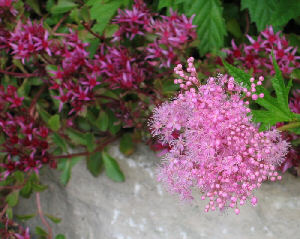
star-shaped two-tone flowers seen above with a fluffy Filipendula bloom flopped forward on top
for partnership ideas follow the link to Red Perennials & Their Companions
If you thought you had enough of this genus in your gardens already, think again. You may want to try a few of the forms below and grow them well with the information provided to assist you.
numerous Sedum forms
red Sedum
Sedum with silver foliage
white Sedum
yellow Sedum
Sedum with variegated foliage
SEMPERVIVUM
Commonly called Hens and Chicks, these succulents produce evergreen rosettes of foliage that make excellent edging plants, rock garden specimens or wonderful residents in rock walls. Their starry flowers appear on bizarre thickened stalks but it is the wide range of foliage selections that creates the most interest in any garden situation.
Sempervivum tectorum
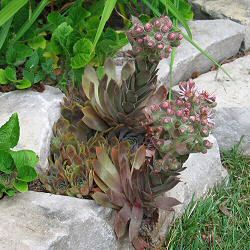
where: edging borders, rock gardens, walls, containers
with: Thymus spp.
STACHYS
 A very popular edging plant, Lamb's Ears has woolly, silvery-gray foliage that looks like its common name implies. The flowers attract bees and many people remove them or grow the non-flowering form noted below. There are even forms with foliage of a more golden colour.
Stachys: Lamb's Ears
A very popular edging plant, Lamb's Ears has woolly, silvery-gray foliage that looks like its common name implies. The flowers attract bees and many people remove them or grow the non-flowering form noted below. There are even forms with foliage of a more golden colour.
Stachys: Lamb's Ears
with: spring bulbs, other grey-foliaged plants (Santolina), evergreens, Yucca filamentosa
with: lemon yellow Tulipa 'Fringed Elegance'
gray colour with: pink, blue or mauve flowers i.e. Diascia, Veronica
with: Allium, Arabis alpina, Arabis caucasica, Carex glauca, Coreopsis verticillata including 'Moonbeam',
with: Campanula carpatica 'White Clips', Dianthus, Echinacea purpurea
with: Euphorbia epithymoides, Gypsophila paniculata
with: Iris x germanica, Iris reticulata, Lavandula (as edging for walkway), Lilium (lemon yellow)
with: Lythrum, Malva moschata, Penstemon, including P. digitalis 'Husker Red'
with: Platycodon grandiflorus, Salvia officinalis 'Purpurascens', Salvia x superba
echo in front of: Malva moschata 'Rosea'
in front of: Papaver orientale including salmon-pink forms
beside: Helianthemum 'Wisley Pink', Heuchera sanguinea
combined with: Armeria maritima 'Dusseldorfer Pride', Allium schoenoprasum, Salvia x superba,
Artemisia (feathery forms) & Achillea
combined with: Alchemilla mollis & Nepeta x faassenii
combined with: Salvia 'East Friesland' & Achillea x 'Moonshine'
combined with: Yucca smalliana & Sedum 'Autumn Joy'
Stachys byzantina 'Silver Carpet': non-flowering Lamb's Ears
with: Aster x frikartii 'Monch', Aster novae-angliae 'Hella Lacy', Delphinium (light blue)
with: Rosa 'Pearl Drift' & Convulvulus sabatius (C. mauritanicus)
with: Hemerocallis (lemon yellow)
behind: Eryngium x oliverianum
in front of: Brunnera macrophylla
combined with: Achillea x 'Moonshine', Nepeta 'Blue Wonder', Coreopsis 'Moonbeam' & Arrhenatherum elatius
var. bulbosum 'Variegatum'
Stachys 'Helen von Stein': non-flowering, large soft silvery leaves, 10"x18"

seen in the border around this page, and in the images at the top of the page and directly above
combined with: Pennisetum alopecuroides 'Hamelyn' & Echinacea purpurea
with: Nepeta faassenii, Thymus praecox
You can find more information and partnership ideas for this lovely perennial at the following link.
Lamb's Ears with silver foliage
THYMUS
Many creeping forms make an excellent drought-tolerant groundcover while taller, bushier forms can be used as a low hedge. All make wonderful edging plants with flowers of various colours and some provide variegated foliage for additional interest once the bloom is finished.
Thymus: Thyme
where: between flagstones, as a ground cover in hot, dry sites, as edging for
informal paths
with: Allium, including A. schoenoprasum
with: Dianthus, Sedum, Sempervivum, Helianthemum nummularium, Lavandula
underplanted with hardy bulbs: Allium, Muscari, Crocus, Narcissus (small forms)
with: Phlox (low-growing, sun-loving forms)
in front of: Euphorbia epithymoides
Thymus x citriodorus: Lemon Thyme, 6-12"x12-18", pale lilac flowers
with: Dianthus deltoides 'Zing'
combined with: Campanula carpatica 'China Doll' (azure-blue), Potentilla 'Miss Willmot' & Sedum 'Dragon's Blood'
Thymus praecox: Creeping Thyme, Mother of Thyme
with: Stachys 'Helen von Stein'
Thymus pseudolanuginosus: Woolly Thyme, fuzzy gray-green foliage, 1-2"x12-23"
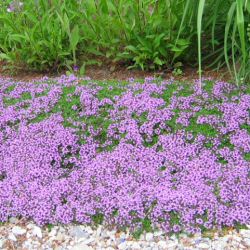
for textural contrast with: Lavandula
Thymus serphyllum: Mother-of-Thyme, pale pastel purple form
echo with: Scilla scilloides of a similar shade
Thymus serphyllum: Mother-of-Thyme, rose-purple, 6-8", vigorous mat-forming
combined with: Sedum (yellow) & Arenaria verna
Thymus serphyllum 'Coccineus': Red Creeping Thyme, aromatic leaves, reddish-pink flowers, to 10"x24"
with: Thymus serphyllum 'Album'
with: Yucca filamentosa
combined with: Dianthus gratianopolitanus 'Tiny Rubies', Dianthus deltoides 'Albus', Veronica 'Crater Lake Blue',
Artemisia 'Silver Brocade' & Geranium sanguineum
Need more Thyme? Find suggestions at the following link.
pink Thyme
Thymes with silver foliage
Thymes with variegated foliage
VERONICA
 While many of the taller forms of Speedwell are well known and commonly used in mid to rear border situations, some lovely types are of a short stature perfect for border edges. Provide the well-drained conditions they require and try to avoid watering the foliage where possible and they will amply reward you with spikes of variously-coloured, long-blooming flowers.
Veronica allionii: Alpine Speedwell, violet-blue, 6"x12"
While many of the taller forms of Speedwell are well known and commonly used in mid to rear border situations, some lovely types are of a short stature perfect for border edges. Provide the well-drained conditions they require and try to avoid watering the foliage where possible and they will amply reward you with spikes of variously-coloured, long-blooming flowers.
Veronica allionii: Alpine Speedwell, violet-blue, 6"x12"
where: edger in full sun to part shade, rock gardens
Veronica alpina 'Goodness Grows'
Veronica austriaca spp. teucrium: Hungarian Speedwell, 8-12"x12"
formerly: Veronica latifolia, Veronica teucrium
this includes the cultivars: 'Crater Lake Blue & 'Trehane'
to go with: spring & early summer blooming Euphorbia
with: Heuchera
Veronica austriaca spp. teucrium 'Shirley Blue'
also see: Veronica teucrium 'Shirley Blue' below
combined with: Iris x germanica (blue) & Tanacetum coccineum
combined with: Iris x germanica (yellow & cream) & Paeonia (a single white)
combined with: pink Heuchera, white Dianthus, blue Iris x germanica, all near Chrysanthemum coccineum
with: hot crimson Dianthus deltoides
beside: pink Gypsophila repens 'Rosea'
Veronica chamaedrys 'Miffy Brute': dwarf, variegated foliage, blue flowers

above with: Hosta and Aruncus in shade
Veronica dabneyi: Pink Speedwell, pale pink, 6"x12"
Veronica filifolia: sky blue, 2-4"x12-18"
where: rock gardens, walls, as edger
Veronica incana
Veronica peduncularis 'Georgia Blue'
Veronica prostrata: Creeping Speedwell, 4"x12"
this includes the cultivars: 'Heavenly Blue' & 'Mrs. Holt'
where: walls, rocks gardens, as edger
Veronica repens
Veronica teucrium: Hungarian Speedwell, 8-12"x12"
synonym: Veronica latifolia, Veronica austriaca spp. teucrium
this includes the cultivars: 'Crater Lake Blue & 'Trehane'
to go with: spring & early summer blooming Euphorbia
with: Heuchera
Veronica teucrium 'Shirley Blue'
also see: Veronica austriaca spp. teucrium 'Shirley Blue' above
sometimes referred to as: V. austriaca, V. prostrata, V. teucrium dubia, V. rupestris or V. latifolia
Veronica whitleyi
The genus Veronica has many choices that can enhance your garden immensely. If those above haven't satisfied your needs, follow the links below for more ideas and care details.
pink Veronica
purple Veronica
red Veronica
Veronica with silver foliage
white Veronica
All of our own Gardens By The Bay pages can be accessed by clicking on the links below.
HOME
GARDEN POETRY |
GARDEN POETRY MUSE
GEORGIAN BAY VIEW
BOTANICAL LATIN - BASICS
COLOR THEORY
THE GARDENS
CORNER GARDEN CONSTRUCTION |
CORNER GARDEN PLANTING |
LONG GARDEN
EAST GARDEN |
HOSTA GARDEN |
NORTH GARDEN |
WINTER GARDENS
PLANT PARTNERSHIPS
BLUE PERENNIALS Aconitum -
Geranium |
Iris - Vinca
BULBS Allium - Hyacinthus |
Narcissus only |
Tulipa only |
Minor Bulbs
BUTTERFLY MAGNETS Anaphalis - Hemerocallis |
Liatris - Veronicastrum
 DAYLILIES Spider & Unusual Form DAYLILIES Spider & Unusual Form EDGERS Arabis - Iris |
Nepeta - Veronica
FOLIAGE PERENNIALS
Alchemilla - Tanacetum
HOSTA Hosta - all
HUMMINGBIRD-FRIENDLY PERENNIALS Alcea - Salvia
ORANGE PERENNIALS Achillea - Tulipa
ORNAMENTAL GRASSES Acorus - Imperata |
Miscanthus - Spodiopogon
PINK PERENNIALS Achillea - Lilium |
Lychnis - Veronica
PURPLE PERENNIALS Aconitum - Liatris |
Polemonium - Veronica
RED PERENNIALS Achillea - Veronica
SHADE PERENNIALS Aegopodium - Erythronium |
Ferns - Polemonium |
Polygonatum - Vinca
SILVER FOLIAGE PERENNIALS
Achillea - Cerastium
|
Cornus - Limonium
|
Lunaria - Veronica
SIMPLY SPECIAL PERENNIALS Acanthus - Saxifraga
WHITE PERENNIALS Achillea - Iris |
Kalimeris - Yucca
YELLOW PERENNIALS Achillea - Hypericum |
Inula - Verbascum
VARIEGATED-FOLIAGE PERENNIALS Acorus - Erythronium |
Hakonechloa - Lysimachia |
Miscanthus - Yucca
PLANT PROFILES
Dianthus 'Tiny Rubies' |
Geranium |
Geum coccineum |
Kerria japonica |
Knautia macedonica
Paeonia tenuifolia |
Papaver somniferum |
Rudbeckia |
Salvia 'East Friesland'
Trollius |
Veronica 'Sunny Border Blue'
PROPAGATION
DIVISION - SPRING ONLY |
DIVISION - FALL ONLY |
DIVISION - SPRING OR FALL |
DO NOT DIVIDE
FERTILIZATION
EDGERS Arabis - Iris |
Nepeta - Veronica
FOLIAGE PERENNIALS
Alchemilla - Tanacetum
HOSTA Hosta - all
HUMMINGBIRD-FRIENDLY PERENNIALS Alcea - Salvia
ORANGE PERENNIALS Achillea - Tulipa
ORNAMENTAL GRASSES Acorus - Imperata |
Miscanthus - Spodiopogon
PINK PERENNIALS Achillea - Lilium |
Lychnis - Veronica
PURPLE PERENNIALS Aconitum - Liatris |
Polemonium - Veronica
RED PERENNIALS Achillea - Veronica
SHADE PERENNIALS Aegopodium - Erythronium |
Ferns - Polemonium |
Polygonatum - Vinca
SILVER FOLIAGE PERENNIALS
Achillea - Cerastium
|
Cornus - Limonium
|
Lunaria - Veronica
SIMPLY SPECIAL PERENNIALS Acanthus - Saxifraga
WHITE PERENNIALS Achillea - Iris |
Kalimeris - Yucca
YELLOW PERENNIALS Achillea - Hypericum |
Inula - Verbascum
VARIEGATED-FOLIAGE PERENNIALS Acorus - Erythronium |
Hakonechloa - Lysimachia |
Miscanthus - Yucca
PLANT PROFILES
Dianthus 'Tiny Rubies' |
Geranium |
Geum coccineum |
Kerria japonica |
Knautia macedonica
Paeonia tenuifolia |
Papaver somniferum |
Rudbeckia |
Salvia 'East Friesland'
Trollius |
Veronica 'Sunny Border Blue'
PROPAGATION
DIVISION - SPRING ONLY |
DIVISION - FALL ONLY |
DIVISION - SPRING OR FALL |
DO NOT DIVIDE
FERTILIZATION
BULBS |
ORNAMENTAL GRASSES |
PERENNIALS |
SHRUBS |
VINES
LINKS
GARDENS |
LOCAL GARDENS |
BOTANICAL TERMINOLOGY
GARDENING BOOKS |
NON-GARDENING
HOME
|
|
|